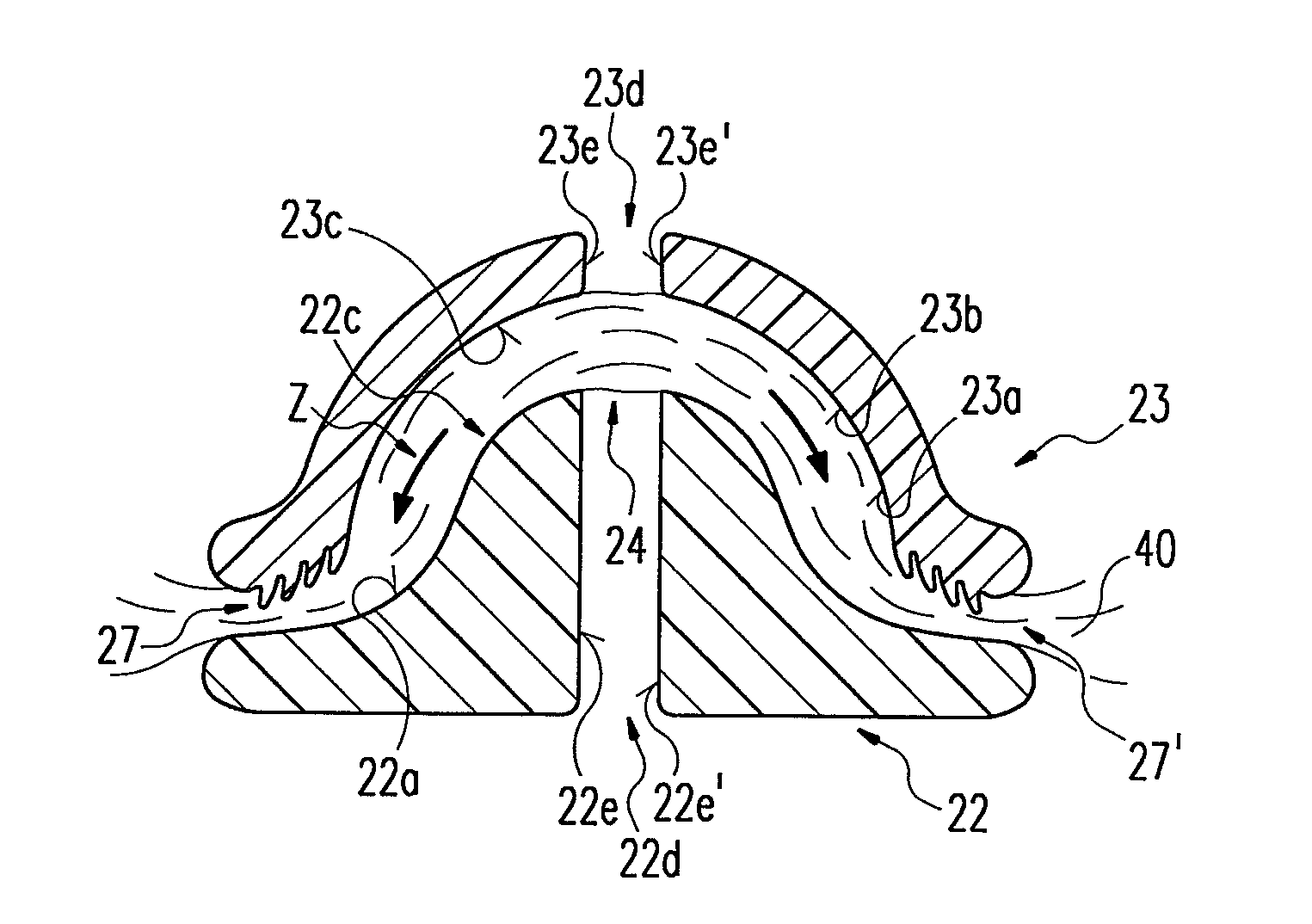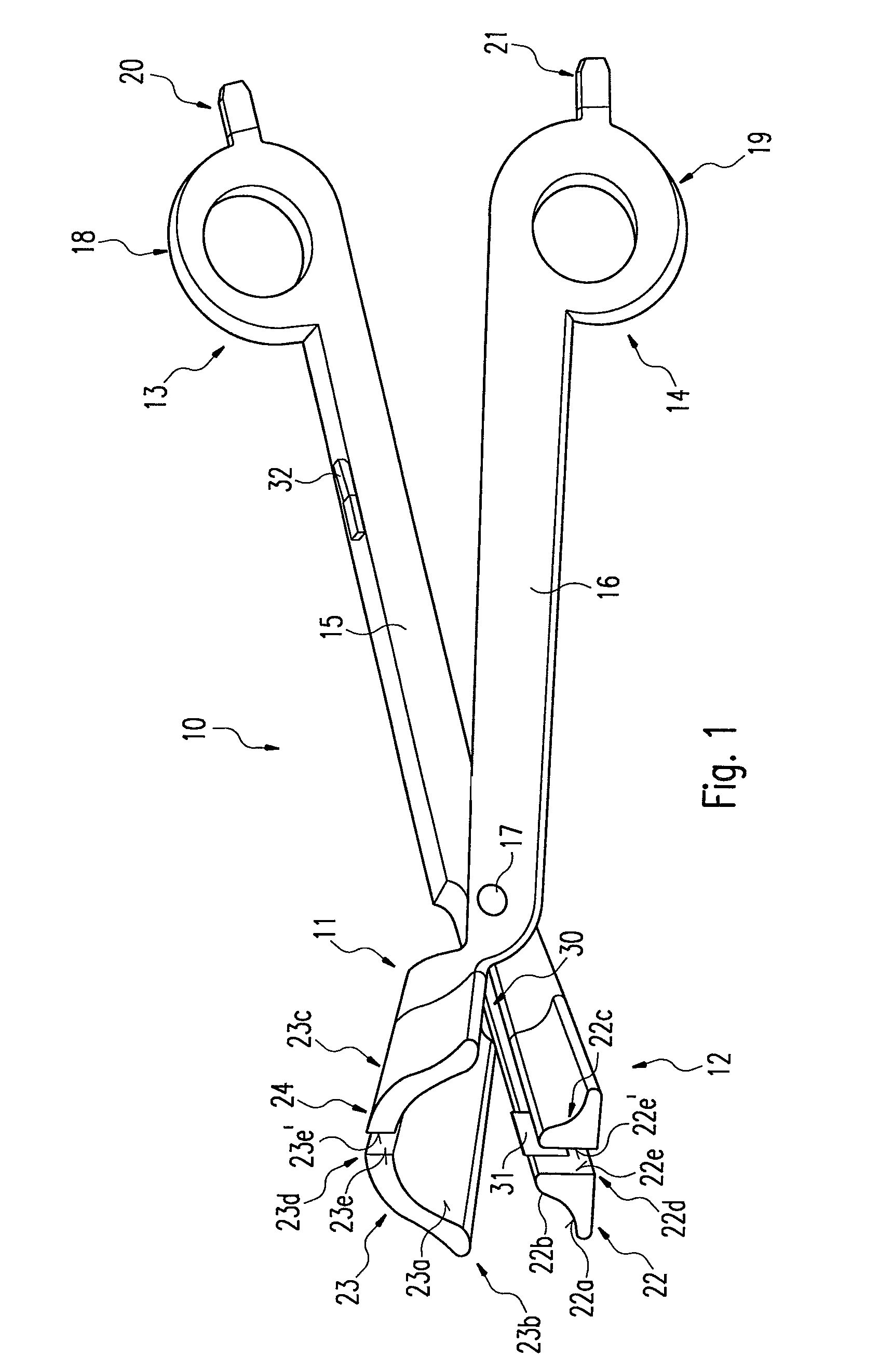Electrosurgical instrument with opposing jaws, central knife, and barbs for maintaining clamping tension on tissue even after opening jaws
a technology of surgical instruments and jaws, applied in the field of electrosurgical instruments, can solve the problems of increasing the risk of infection, promoting abrasive wear of cutting sections, and mechanical strain on cutting instruments, so as to reduce the force applied to cut vessels or tissues by means of cutting instruments, and reduce the risk of infection
- Summary
- Abstract
- Description
- Claims
- Application Information
AI Technical Summary
Benefits of technology
Problems solved by technology
Method used
Image
Examples
third embodiment
[0058]FIGS. 2 and 3 each depict a considerably enlarged front elevation of an electrode arrangement as a cross-section in a second and third embodiment respectively. The electrode parts 22, 23 correspond essentially to the embodiment of those depicted in FIG. 1. These also have passages 22d, 23d serving as a guide opening 24 for a cutting instrument as described in FIG. 1. A surface profile supporting a clamping effect of clamped tissue 40 is configured on at least one clamping region. The profile is preferably configured at both end areas of the respective clamping region or the respective clamping regions 22c, 23c and additionally moves the tissue 40 in a direction of traction Z defined by the clamping regions 22c, 23c or prevents any retreating of the tissue 40 against this direction of traction Z.
[0059]As depicted in FIG. 2, coagulating surfaces 22a, 23a of the electrode parts 22, 23 are formed at their two end areas in such a way that the tissue 40 is taken along in the directi...
fourth embodiment
[0062]FIG. 4 depicts an enlarged front elevation of an electrode arrangement as a cross-section in a In this case, passages 22d, 23d divide the respective electrode parts 22, 23 into at least two areas in such a way that the electrode parts 22, 23 each have opposing split surfaces 22e, 22e′ and 23e, 23e′ arranged in a tapering manner relative to each other in the direction of the coagulating surfaces 22a, 23a. Since the split surfaces 22e, 22e′, 23e, 23e′ of the corresponding electrode parts 22, 23 converge on one cutting area 25, this further guarantees precise guidance of the cutting instrument 30 here. The part of the passages 22d, 23d directed away from the cutting area 25 is particularly suited to reprocessing, that is to a cleaning of the instrument 10 after a successful intervention or also to the subsequent application of a coating of the split surfaces 22e, 22e′, 23e, 23e′ with, for example, a wear-resistant layer of ceramic, since improved accessibility is guaranteed due ...
fifth embodiment
[0063]FIG. 5 depicts an enlarged front elevation of an electrode arrangement as a cross-section in a This embodiment corresponds essentially to the one depicted in FIGS. 1 and 2. The difference is that clamping regions 22c, 23c are configured here with different radii of curvature; the radius of curvature of the concavely configured clamping region 23c is larger than the radius of curvature of the convexly configured one. As a result, the respective coagulating surfaces 22a, 23a are also correspondingly curved. The curvatures 22b, 23b run around longitudinal axes of the distal ends in such a way that tissue 40 held between the distal ends 11, 12 and running perpendicular to the longitudinal axes is held with increasing compression relative to central sections of the clamping regions 22c, 23c. Advantageously, tissue 40 once clamped here is arrested particularly securely between the clamping regions 22c, 23c due to the increasing compression. Any sliding of the tissue 40, once graspe...
PUM
 Login to View More
Login to View More Abstract
Description
Claims
Application Information
 Login to View More
Login to View More - R&D
- Intellectual Property
- Life Sciences
- Materials
- Tech Scout
- Unparalleled Data Quality
- Higher Quality Content
- 60% Fewer Hallucinations
Browse by: Latest US Patents, China's latest patents, Technical Efficacy Thesaurus, Application Domain, Technology Topic, Popular Technical Reports.
© 2025 PatSnap. All rights reserved.Legal|Privacy policy|Modern Slavery Act Transparency Statement|Sitemap|About US| Contact US: help@patsnap.com



